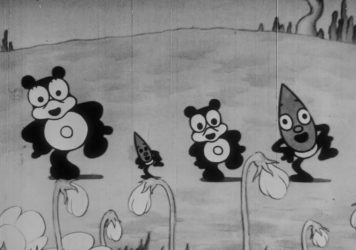
The Shanghai Animation Film Studio was a vital part of China’s animation industry, both in terms of forming national styles as well as creating international interest in the country’s contributions to the medium.
An online Chinese film season, running until 12 May, boasts an exciting selection of shorts and features from the studio’s history; predominantly the golden age between 1957 and the mid-’60s when they enjoyed greater artistic freedom and no-strings-attached government funding. It was a period of considerable development in which the studio experimented with mixing aesthetics from Soviet and Western animation (primarily that of Walt Disney) with traditional domestic art.
The studio’s tumultuous history can be seen in the selection itself, with a scarcity of work available from the late ’60s through to the ’80s. The main reason for this gap was the Cultural Revolution, which led to complications for the studio; for one, studio head and director Te Wei was held in solitary confinement for over a year, resulting in the studio temporarily shutting down and a number of its already released films being banned.
The earliest film featured in this retrospective is Wan Guchan’s Fishing Child from 1959. The Wan brothers were trailblazers of Chinese animation and dominated the studio; their name pops up frequently in the programme, with the studio’s most high-profile feature, Monkey King: Havoc in Heaven, directed by Wan Laiming and produced by his siblings.
Based on a popular folk tale by Zhang Shijie, Fishing Child is characterised by righteous anti-imperialism/colonialism – a fable about fishermen resisting the oppression of the West. Set at the end of the Qing Empire, before the Boxer Rebellion, it’s told with tactile cut-out animation (and even some stop-motion) that embodies both a cultural history and the aforementioned resistance movement.

Its rugged but beautiful animation style was pioneered by Guchan and harks back to traditional Chinese paper-cutting, also displayed in his 1963 film Golden Conch. The tales themselves are a little samey – there’s more than one mystical princess fished out of the sea – but the rough-hewn style is a fascinating contrast to the more ethereal sensibilities of the rest of the programme.
Directed by Te in 1960, Where is Mama immediately distinguishes itself with a watercolour style that feels like a precursor to Isao Takahata’s The Tale of the Princess Kaguya. (Given that Hayao Miyazaki is said to have visited Shanghai Animation Film Studios before the foundation of Studio Ghibli, it’s not a huge leap to draw a line between the two.) Where is Mama is ostensibly a children’s tale, with simple narration based on repetition and basic civic lessons via the natural world. As Alex Dudok de Wit notes: “The chirpy voiceover reminds us that all plants need to be guarded against ‘pests’.”
Te’s 1963 short The Cowboy’s Flute also stands as one of the prettiest films on offer here, the director having further refined his watercolour style. Since the two characters are a boy and his water buffalo, dialogue isn’t needed, and so the film communicates visually and musically instead. Te’s artful minimalism is again reminiscent of Takahata, with delicate line- and brush-work that’s just as expressive as the movements and character drawings that they serve.
The haziness of Te and co-director Qian Jiajin’s art direction marries well with the film’s dreamworld setting; the colour washes away as the boy sleeps, reduced to gentle pink and red tones. Te’s looser, more expressive style allows for him to eschew dialogue entirely this time around, a further confirmation of the director’s minimalist inclinations. It’s serene and contemplative work compared to the loud and chaotic satire of the Wan brothers’ films.

Feeling from Mountains and Water, made in 1988, was Te’s final film and the last by the original crop of animation leaders from Shanghai Animation Film Studio’s golden age. (Following his arrest, Te was forced into exile and his career was put on hold.) It is perhaps the greatest realisation of his singular water-and-ink style. As with Where is Mama, Te’s choice of subject matter chimes perfectly with his fluid animation. Notably, he also intentionally leaves the hand of the artist on full display, so imperfections such as smudges or slightly rough brushstrokes become part of the film’s texture.
Directed by Wan Laiming and Tang Chen, the studio’s big cel-animated feature Monkey King: Havoc in Heaven is less conceptually exciting. Like so many animated works (Dragon Ball, The God of High School, Digimon; the list goes on) its characters and themes are lifted from the classic 16th century Chinese novel ‘Journey to the West’. But it is also emblematic of the diverse art direction evident across the studio’s output, adopting features from Chinese stage art in its art direction and rhythmic action sequences. It’s a little more lavish and grandiose than the other shorts, full of bright yet soft colours and swirling patterns.
Just as it’s hard to pin down the exact inspirations for Monkey King: Havoc in Heaven, the sheer breadth of Shanghai Animation Film Studio’s influences makes it hard to identify a house style beyond a shared affinity for traditional folklore and national art. And that’s precisely what makes the studio’s filmography, and the chance to see it now in its restored glory, so thrilling.
The Shanghai Animation Studio Retrospective can be viewed as part of Chinese Cinema Season at chinesefilm.uk in association with Trinity CineAsia
Published 4 Mar 2021

The first and only film from Miyazaki protégé Yoshifumi Kondo stands among the studio’s best works.

Rare shorts from 1917 to 1941 are now streaming in celebration of 100 years of anime.

Isao Takahata’s unrealised passion project was intended as a follow-up to Grave of the Fireflies.